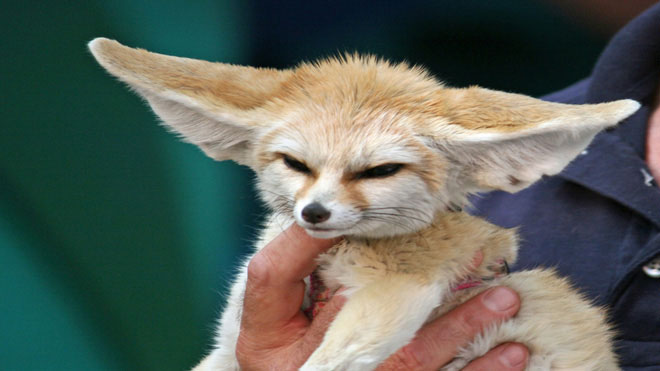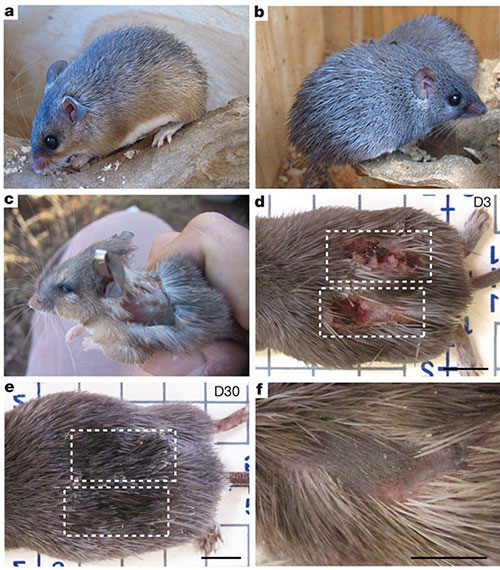6 most adaptable animals in arid desert
The desert is hot, lack of water, but animals must still exist. By the way, you'll know right away.
Talking to the desert is about arid, exhausting hot sun. But even in the land seems to be all sand is sand, animals still live. And to survive in difficulty, they "peek" out all kinds of "wisdoms".
1.: Dissipate heat through big ears

Fennec foxes (Vulpes zerda) are also known as North African foxes, mainly living in the Sahara desert, Sinai peninsula, Arava desert and Arabian desert.
The characteristic of Fennec foxes is extremely large ears. They not only make the fox's face too cute, but also a particularly effective tool to handle body temperature.
Across the broad ears are blood vessels that allow Fennec foxes to dissipate excess heat. In addition, these ears are extremely sensitive, helping them hear the sound of prey moving in the sand.
2.: Turn your eyes into sunglasses

While the Fennec fox invested in ears to facilitate nightlife, the Meerkat civet (Suricata suricatta) chose to change the eyes to eat in the midday sun.
In their eyes are black patches, acting like natural sunglasses. Thanks to that, the Meerkat civet can eat even at noon, when the Sun's light is the most intense.
In particular, these eyes also have a protective film to shield the pupil from being attacked by dirt while they use their feet to dig the dirt.
3. Mouse Acomys: Very fast skin regeneration

The desert is harsh but still full of predators. And because there are hunting animals, there are some wisest prey. Acomys mouse is such a "prey".
Acomys mouse skin is extremely thin and very easily torn. But that's not the weakness of this rat, but the extremely effective escape strategy. When attacked by predators, Acomys mice will "test" them with an array of skin, as it can regenerate lost skin very quickly.
Not only skin, Acomys mice can regenerate both the hair, sweat glands, and even cartilage.
4. South African ground squirrel: Remove the tail to cover the head

South African ground squirrel (Xerus inauris) is a popular rodent in the driest areas of South Africa. They are special because they have a very lovely habit, that is to take their cotton tail as a sun umbrella.
There is that behavior because of the practice of eating during the day. They also like to burrow wide and open, sometimes up to 100 entrances for 1 cave.
70% of South Africa's daily squirrel activities are foraging outside. And to help with the scorching sun, they bent their fluffy tails and covered their backs, covering their heads to cool.
5. Gila monster: Eat once for a few months

Gila monster (Heloderma suspectum) is a poisonous salamander commonly found in the southwestern United States and Mexico. It looks fat, but only eat 5-10 meals a year.
In return, every time you eat, the monster Gila can "eat" a meal equal to one third of your body weight. Fat will be stored in a big tail, enough for it to take off for several months.
6. Long-tail pheasant: No need to drink water for life

Long-tailed pheasant (Geococcyx) is also a common animal in the southwestern United States and Mexico. It has the ability to fly short, but rarely uses wings, just like running.
The speed of the long-tail pheasant is quite impressive, can be as fast as 42km / h. But the most unique thing is that this bird does not need to drink water. It can even live a lifetime without touching a single drop of water.
But that is absurd, because what kind of creature does it live without water? In fact, they still need water, but the animal has absorbed enough moisture in the food every day - from insects, lizards, scorpions, to smaller birds.
- Desert - CO2 sink
- Believing that the most arid desert in the world is located in Antarctica
- The shocking truth about the desert is hard to believe
- 'Miracle' in the town located in the world's most arid desert
- Israel's advanced irrigation method has turned arid desert into a place to grow vegetables and fish
- The phenomenon of snowfall is very strange in the Atacama desert
- The arid Sahara desert used to be the place where the largest marine creatures lived
- Arid desert 'risen' covered with roses
- Building a huge lake system in the desert
- The world's most arid desert turns into a colorful sea of flowers
- Great hot escape of animals in the desert
- Lake water 2000 years strange between arid desert
 Animal 'suffering' after hibernation
Animal 'suffering' after hibernation Why do goats climb well?
Why do goats climb well? Scientists were surprised to see chimpanzees eating turtles
Scientists were surprised to see chimpanzees eating turtles Giant catfish died deadly due to drought in Thailand
Giant catfish died deadly due to drought in Thailand